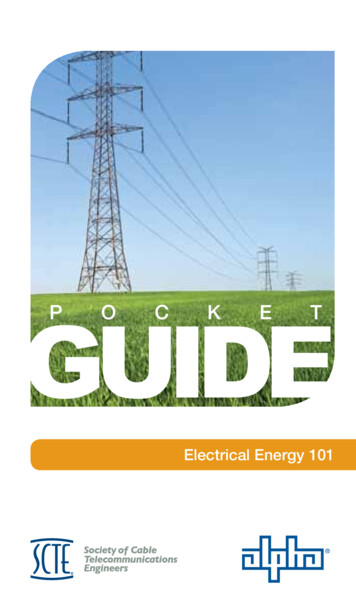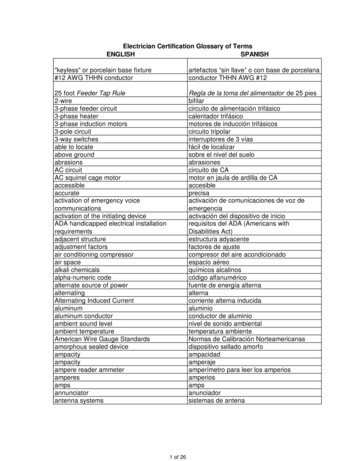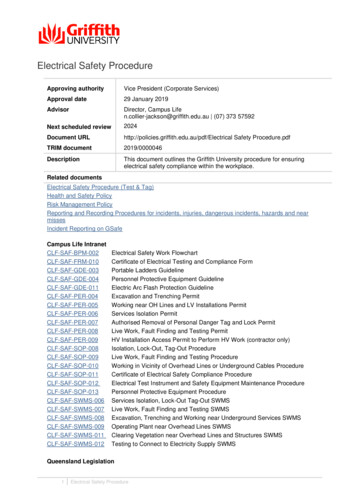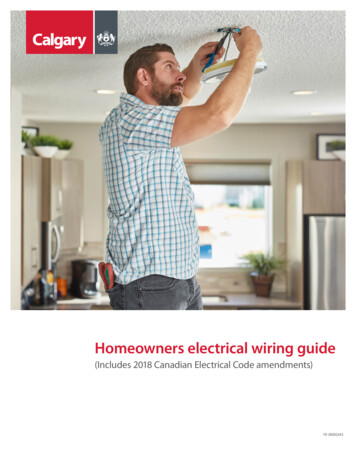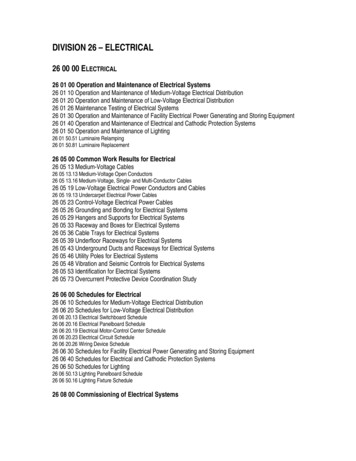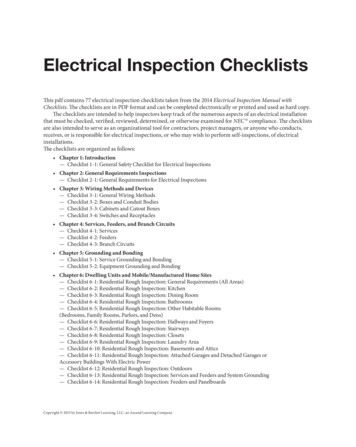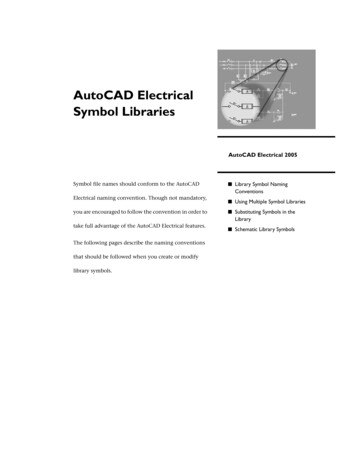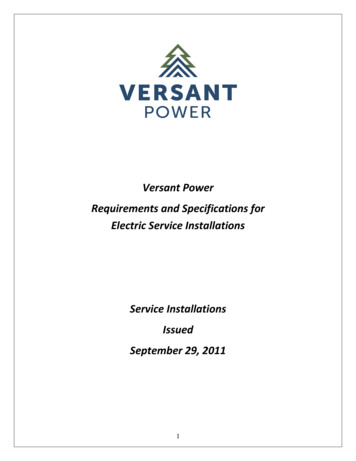
Transcription
Versant PowerRequirements and Specifications forElectric Service InstallationsService InstallationsIssuedSeptember 29, 20111
PrefaceThis handbook is effective September 29, 2011 and is a revision of an earlier edition dated August 17, 2001. All earlier editions of,and supplements to, this handbook are superseded and should be destroyed.If you need additional copies of this handbook, please call or write us at:Versant PowerPlanning DepartmentPO Box 932Bangor, Maine 04402-9987As you read this handbook, you will see the words “Company” and “we” used many times referring to “Versant Power”.Our corporate headquarters is located at:970 Illinois AvenueBangor, Maine 04401207-945-5621Need More Information?To contact us for information or assistance, please call our Customer Service Center at 947-2414 or 1-800-499-6600.Underground WiresTo contact Dig Safe to locate underground wires before constructionplease call 1-888-DIGSAFE or 1-888-344-7233.Power OutageTo report a power outage or other electrical trouble please call us at973-2020 or 1-800-440-1111.Overhead High-Voltage Line Safety NoticeIn Accordance with Maine Law (Title 35A M.R.S.A., Chapter 7-A) a person may not erect, construct, operate, maintain, transport orstore any equipment or item within 10 feet of an overhead high-voltage line (except as allowed for in the Law). When it is necessaryto carry on any work or activity near an overhead high-voltage line, the person responsible for the work or activity must notifyVERSANT POWER by calling 947-2414 or 1-800-499-6600 at least three (3) business days in advance. VERSANT POWER will makethe necessary mutually acceptable precautionary safety arrangements.Table of ContentsSection I. Introduction101Purpose (8)102National Electric Code (8)103National Electrical Safety Code (8)104Application of Specifications (8)105Special Conditions (8)106Revisions of Requirements (9)107Written Confirmation (9)108Customer’s Premises (9)109Customer’s Responsibility (9)110Access to Premises (9)111Customer’s Liability (10)112Protective Equipment (10)113Rates, Terms and Conditions (10)2
Section II. Definition of Terms201Company (10)202Customer (10)203Dwelling Units (10)204Multi-Family Dwelling (10)205One-Family Dwelling (11)206Voltage Class (11)207Service (11)208Service Drop209Service Lateral210Service Entrance Conductors—Overhead211Service Entrance Conductors—Underground212AWG213NEC & NESC214Terms and Conditions215Service EquipmentSection III. Safety and Adequate Wiring300Work Site Safety Policy301Safe Use302Adequate Wiring303Approval and Permit Requirements304Voltage Variation305Unbalanced Load306Emergency or Standby PowerSection IV. General Information401Application for Service402Temporary Service403Inspection404Right to Refuse and Disconnect Service405Connections406Removal of Seals407Customer Generation408Line and Load Side ConductorsSection V. Types and Applications of Electric Service501General502Characteristics of Service503Applications of Service504High Capacity Services3
Section VI. Overhead Connections from Overhead Secondary Mains601General602Single Service Drop603Central Distribution Point604Point of Attachment of Service Drop605Service Drop Clearances606Low Buildings607Travel Trailers and Other Structures Not Suitable for Direct Service Attachment608Manufactured (Prefabricated) Buildings609Mobile HomesSection VII. Service Entrance Conductors—Overhead701General702Service Head703Installation MethodsSection VIII. Grounding801General802Service Grounding Electrode System803Bonding804Grounding Conductor805Lightning Protection806Surge ProtectionSection IX. Underground Services—General901Customer Costs902Underground Scheduling903Other Underground Facilities904Insurance905Customer Work Responsibility906Soil Conditions907Terminal Poles908Existing Overhead FacilitiesSection X. Privately Owned Underground Services1001General1002Types of Services1003Company Responsibilities1004Customer, Developer, or Builder ResponsibilitiesSection XI. Underground Service from a Company Owned Underground Distribution System1101General1102Types of Services1103Company Responsibilities1104Customer, Developer, or Builder Responsibilities4
Section XII. Underground Service—From Existing Underground Mains1201General1202Underground Ducts1203Underground Conductors1204Company Conversion to Underground Distribution SystemSection XIII. Service Disconnecting ce of Disconnecting Means and Meter Equipment1305Metered and Unmetered Wires1306Type of Disconnecting MeansSection XIV. Metering Equipment1401General1402Meter Sockets1403Meter Location1404Clearance for Metering Equipment1405Identification of Meters1406Multi-Connection Points1407Installation of Meter Devices1408Outdoor Meter Installation1409Pole Mounted Meters1410Prefabricated Meter Centers1411Meter Pedestals1414Instrument Transformer Cabinets1412Multiple Occupancy1413Instrument Transformer MeteringSection XV. Customer Equipment1501General1502Motors1503Power Factor Correction1504Arc Welders1505AntennasAppendix: Exhibits and Drawings105150201202203.1203.2203.3Line Voltage VariationsPrivate Line Pole MarkingVertical Clearances of Wires Above Ground, Roadway, Rail or Water Surfaces @ 120’ FMinimum Clearances for Service DropsClearances from Buildings and Other Installations Except BridgesClearances from Buildings and Other Installations Except BridgesConductor Categories for Clearances5
142715271627182901290229032904Minimum Clearances for Services 0 – 750 VoltsClearance Between Electric Meters / Equipment and L.P. or Natural Gas EquipmentClearance Between Electric Cables / Equipment and L.P. or Natural Gas EquipmentDIGSAFE Safety Zone and Tolerance ZoneFiberglass Single Phase Padmount Transformer Foundation 25 to 50 KVAPrecast Single-Phase Padmount Transformer Foundation 25 thru 167 KVAPrecast Three-Phase Padmount Transformer Foundation 75 thru 750 KVATrench & Conduit Depth for Primary Underground InstallationsMulti-Conduit Risers on VERSANT POWER Co Owned PolesTerminal Pole Except Public Way, 600 Volt or LessTerminal Pole Except Public Way, Single Phase 15 KV and 35 KVTerminal Pole Except Public Way, Three-Phase 15 KV and 35 KVPadmount Transformer Locations Near Structures and RoadwaysTemporary Service Structure for Use During Building ConstructionRigid Steel Mast 100 - 400A Service to Low BuildingRigid Steel Mast 100 – 400A Service – Multiple Meters to Low BuildingOverhead Conduit Service 200 Amps MaximumOverhead Cable Service 400 Amps MaximumOverhead Service to Mobile Home, Travel Trailer CustomerUnderground Secondary Service on Company Owned Poles100 – 400 Amp Self-Contained Meter Private Pole Mounted100 – 200 Amp Outdoor Underground Metering PedestalMulti- Metering Pedestal Structure200 – 400 Amp Outdoor Underground Pedestal Metering4Class 320 Meter EnclosuresMast Mounted Current TransformersBuilding Mounted Current TransformersOutdoor Pedestal for Transformer Rated Pad Mount MeteringCurrent Transformer Rated Service, Outdoor CT CabinetMetering Standards for Three-Wire 120/240 Volt Single-Phase With Grounded Neutral (Removed)Metering Standards for Network Three-Wire 120/208 Volt (Removed)Metering Standards for Three-Phase Four-Wire Wye (Removed)Metering Standards for Three-Phase Three-Wire Delta (Removed)REQUIREMENTS AND SPECIFICATIONS FORELECTRIC SERVICE INSTALLATIONSSECTION IINTRODUCTION101. PurposeThese specifications are issued for the use of customers, architects, engineers and electrical contractors and are intended toestablish standards that will insure safe and satisfactory service. These requirements are not a complete set of rules and cover thecommon types of installations as supplied by the distribution system of the Versant Power (VERSANT POWER). Installations notspecifically addressed herein may require modifications to these requirements.The customer shall comply with these specifications and the Company will cooperate with the customer and electrical contractor inthe application of the specifications. These Standard Requirements are on file with the Maine Public Utilities Commission (MPUC).102. National Electrical CodeThese specifications are based on and supplementary to the latest edition of the National Electrical Code (NEC) issued by theNational Fire Protection Association, and are not intended to conflict with the NEC or municipal and state ordinances. The NEC ishereby made a part of these requirements by reference. Each customer is responsible for having all wiring installed in accordancewith the NEC and the requirements of any local inspection authority, and maintained in a safe condition. VERSANT POWER doesnot6
accept responsibility for the condition of the customer’s wiring and equipment, or damage that may result there from. The local orstate electrical inspector is the “authority having jurisdiction” and is, therefore, responsible for interpretation and enforcement ofthe NEC.103. National Electrical Safety CodeThe Company, by law (Title 35A M.R.S.A. Section 2305-A) is required to design, construct, operate and maintain its lines andequipment in conformance with the applicable provisions of the most recent edition of the National Electrical Safety Code (NESC).Additionally, any lines that the Company purchases must be in conformance with the edition of the NESC in effect at the time ofpurchase.104. Application of SpecificationsThese specifications apply to all new installations, all existing installations to which alterations are made, and all other installationsthat are considered unsafe and hazardous as determined by the Company’s inspection.105. Special ConditionsWhen special conditions prevail or when more information is needed, Company representatives will give attention on request. Inspecial installations the Company may alter these requirements, but any departure from the requirements will not be considered asestablishing a precedent.106. Revisions of RequirementsThe contents of this handbook are effective September 29, 2011, and supersede all similar requirements previously issued. Revisionsof this information will be made when necessary, and the Company reserves the right to make such revisions. The Company willendeavor to notify those concerned when such changes are made but cannot guarantee to give such notice to all persons who mayhave received this handbook. It is urged that all architects, engineers, contractors, electricians and other who are interested submittheir names and addresses to be included on the mailing list to:Versant PowerPO Box 932Bangor, Maine 04402-0932107. Written ConfirmationThe Company will confirm in writing, upon request, all information given regarding service characteristics, applicable rate, serviceentrances and meter locations. The Company is not responsible for misunderstandings of any nature which may result frominformation given orally, unless confirmed in writing. In order to avoid delays and possible expensive changes, the above informationshould always be obtained before purchasing equipment or starting construction.108. Customer’s PremisesIn the absence of negligence or contract, the Company shall not be liable for damage to the person or property of the customer, orany other persons arising from the use of electricity, or the presence of the Company’s appliances and equipment on the customer’spremises. All property owned by the Company and located on the customers’ premises shall be deemed to be personal property andtitle thereto shall remain in the Company, and the Company shall have the right at the expiration of service to remove all of itsproperty whether affixed to the realty or not.109. Customer’s ResponsibilityThe customer shall be responsible for the safekeeping of the property of the Company on his/her premises, and, in the event ofdamage to it, shall pay to the Company any cost of inspection and repairs. The customer shall protect the equipment of theCompany on his/her premises, and shall not permit any person, except an authorized employee or a person authorized by theCompany, to break any seals upon, or do any work on, any meter or other appa-ratus of the Company located on the customer’spremises.110. Access to PremisesThe Company shall have the right of access to a customer’s premises and to all property furnished by the Company installed therein,at all reasonable times during which service is furnished to the customer, and on or after its termination, for the purpose of readingmeters, or inspection and repair of Company facilities used in connection with its service, or removing its property, or for any otherproper purposes.111. Customer’s LiabilityThe customer shall give proper notice to the Company of any substantial increase or decrease proposed in his/her connected load orof any proposed change in characteristics, purpose of use, or location of load. Failure of the customer to give such notice will render7
the customer liable for any damage to meters, transformers, wires and associated apparatus of the Company resulting from the useof increased or changed load.112. Protective EquipmentDuring emergency conditions, it may be necessary to interrupt service without notice to perform necessary repairs or changes, andto restore service without notice when work is completed. In the process of restoring service, conditions of irregular voltage, singlephasing, or phase reversal may occur. Equipment which might be endangered or which might endanger life or damage propertyunder these conditions, must be provided with suitable automatic protective devices by the customer.All motors and electronic equipment such as computers and microprocessors, shall be controlled and protected, by the customer,from damage caused by single-phasing or abnormal voltage conditions. Such disturbances are inherent in all supply systems.The Company cannot be held responsible for damages caused by the customer’s failure to provide adequate protection.113. Rates, Terms and ConditionsThe customer, contractor and those interested are referred to the “Schedule of Rates” and the “Terms and Conditions” as filed withthe MPUC, copies of which may be examined at any office of the Company. Customers or contractors shall also make themselvesaware of the requirements as set forth in Section IV—General Information. Visit our web site at WWW.VERSANTPOWER.COMSECTION II. DEFINITION OF TERMS201. CompanyThe Versant Power (VERSANT POWER).202. CustomerA present or prospective user of the Company’s electric service.203. Dwelling UnitsOne or more rooms for the use of one or more persons as a housekeeping unit with space for eating, living, sleeping and permanentprovisions for cooking and sanitation.204. Multi-Family DwellingA building containing two (2) or more dwelling units. An area being developed for multiple homes or businesses.205. One-Family DwellingA building consisting solely of one (1) dwelling unit.206. Voltage ClassPrimary—2400 volts through 345,000 volts.Secondary—120 volts through 480 volts.See Section V Article 502 for standard secondary voltages.207. ServiceThe supply of electricity to a customer, also the conductors and equipment from the Company’s lines to the customer’s wiringsystem.208. Service DropThe overhead service conductors from the last pole or other aerial support to and including the splices, if any, connecting to theservice entrance conductors at the building or other structure.209. Service LateralThe underground service conductors between the street main, including any risers at a pole or other structure or from transformersand the first point of connection to the service entrance conductors in a terminal box or meter or other enclosure with adequatespace, inside or outside the building wall. Where there is no terminal box, meter, or other enclosure with adequate space, the pointof connection shall be considered to be the point of entrance of the service conductors into the building.210. Service Entrance Conductors—OverheadThe service conductors between the terminals of the service equipment and a point usually outside the building, clear of buildingwalls, where joined by tap or splice to the service drop.8
211. Service Entrance Conductors—UndergroundThe service conductors between the terminals of the service equipment and the point of connection to the service lateral.212. AWGThe American Wire Gauge (AWG) size of wires and applies to copper conductors where used in these requirements. When othermaterial is used, the size shall have a capacity equivalent to copper.213. NEC & NESCThe current edition of the National Electrical Code (NEC) as published by the National Fire Protection Association.The current edition of the National Electric Safety Code (NESC) as published by the Institute and Electrical and Electronics Engineers,Inc.214. Terms and ConditionsThe Terms and Conditions portion of the Company’s Schedule of Rates as filed with and approved by the MPUC.215. Service EquipmentThe necessary equipment, usually consisting of a circuit breaker or switch and fuses, and their accessories, located near the point ofentrance of supply conductors to a building or other structure, or an otherwise defined area, and intended to constitute the maincontrol and means of cutoff of the supply.SECTION IIISAFETY AND ADEQUATE WIRING300 Work Site Safety PoliciesVersant Power Company requires the use of proper personal protective equipment by all Company employees, contractors andcustomers that need to be present on a work site. Persons that are not essential for the work being performed will be asked to stayout of the work site. Persons that need to be present or involved in the work will be required to sign on to a risk assessment beforethe work begins. The risk assessment will address all hazards present at the work site. Whenever possible the hazard should beeliminated (I.E. Open and grounded lines.) If the hazard cannot be removed, the risk assessment will cover what personalprotective equipment is needed and the placement of barriers such as shields or insulated cover up. When anyone new arrives onthe work site, the work will stop and the new arrival will participate in and sign on to a revised risk assessment.If there are people on the work site who are not wearing the proper personal protective equipment or participating and following theplan and risk assessment, Versant Power will cease work and leave the site. This may result in additional charges for subsequenttrips to complete the work at a later date.301. Safe UseTo safeguard the property of the customer and that of the Company, the customer is warned against over fusing either the mainfuses or those on branch circuits. Installing overcurrent protection larger than approved by NEC for a specific wire size, or usingpennies, or other methods which in any way make protective devices inoperative, CAN CREATE A SERIOUS HAZARD.302. Adequate WiringThe NEC states: “This Code contains basic provisions considered necessary for safety. Compliance therewith and propermaintenance will result in an installation essentially free from hazard, but not necessarily efficient, convenient or adequate for goodservice or future expansion of electrical use.” The Company recommends that engineers, architects, electrical contractors and othersmake ample provisions for serving present and future loads. This may indicate more than Code Minimums such as a 100 ampere orlarger service, larger wire size and more branch circuits. A wiring installation that will serve the future as well as the immediaterequirements is a sound investment for the customer.303. Approval and Permit RequirementsIn municipalities where electrical inspections are required by local authorities, approval must be received before installations will beconnected to the Company’s distribution system. Such approval can be obtained from the local inspector by the customer or9
contractor. Where local authorities do not require inspection approval, the wiring contractor shall be required to certify that theinstallation is in accordance with applicable provisions of the NEC. State law requires a permit for electrical work in other than onefamily dwellings, electrical work and equipment incidental to a utility for rendering service, minor electrical repair work, industrialsas applicable by state statute, and other installations and alterations subject to municipal resolution or ordinance. Electricalinspectors will continue to provide inspections for the municipalities they serve, but the state will provide inspections and permitsfor municipalities without inspectors. A Company employee will inspect the service for safety, clearance, grounding, and otherrequirements before connecting (see Section IV, Article 403).304. Voltage VariationThe Company will maintain the voltage delivered to its customers within the limits prescribed in “A” and “B” below. This voltage willbe maintained at the Company’s service terminals, such as at the weatherhead for an overhead service drop or at the transformersecondary terminals for a customer owned underground service.A. For service rendered principally for residential or commercial purposes the normal voltage variation shall not exceed plus orminus five percent ( or -5%) from the standard voltage for any period longer than one (1) minute.B. For service rendered principally for power purposes the normal voltage variation shall not exceed plus or minus ten percent ( or -10%) from the standards voltage for any period longer than one (1) minute.305. Unbalanced LoadThe customer shall at all times take and use energy or generate energy in such a manner that the load will be balanced betweenphases to within nominally 10%.306. Emergency or Standby PowerThe following general requirements apply to customer generating facilities designed to operate isolated from the Company’selectrical system. The Company will provide, upon request, a booklet of recommendations for connecting emergency generators forresidential customers.VERSANT POWER strongly encourages all customers to have a licensed electrician install the equipment necessary to connectemergency generators to their home’s electrical system whether permanently connected or portable. The customer should contacttheir local electrical inspection authority for final approval.Non-Parallel Operation—When the customer makes provision for or installs a generator for the purpose of supplying all or just partof the electrical load, the customers wiring shall be so arranged to prevent back-feeding on the Company power lines. Thisarrangement will prevent interconnection between the Company lines and the customers emergency or standby source of supply.A positive acting, UL listed double-throw switch or transfer device which is acceptable to the Company and meets all of the followingrequirements shall be used.A. When service is manually transferred, this switch must be so arranged as to open all ungrounded conductors of the normalsupply from the Company before any connection is made to the emergency supply.B. The double-throw switch or transfer device must be so constructed and connected as to positively prevent any possibility ofpower from the customer’s emergency source feeding back into the Company’s distribution system.When it is desired to energize all of the customer’s distribution circuits from the emergency source, the above switch may beconnected on the line side of the regular service disconnecting means. The switch should not, however, be connected to the sourceside of the Company power meter. Where this switch is exposed to the weather, it must be of a rain-tight construction.Conductors that may be energized by emergency generating equipment shall not be located in the same conduit or raceway asservice entrance conductors from the Company’s system.When the emergency generator is arranged to serve only specific equipment by use of separate circuits that are not connected tothe normal wiring system, a main transfer switch will not be required. Also refer to Section 407.SECTION IVGENERAL INFORMATION401. Application for ServiceNow that you have spoken with a Customer Service Representative, a VERSANT POWER Field Representative* will visit your site todetermine the location of our meter and the route required for additional poles or underground wires.10
* If you haven’t set up your new account yet, you must do so now. Application for new or enlarged electric service shall be madeby calling our Customer Service Center at 947-2414 or 1-800-499-6600. To avoid delay in receiving service at the desired time, itis essential that the application be made as far in advance as possible.When planning the installation, and before material is purchased, the customer is requested to confer with the Company todetermine the availability of service and location of service and metering facilities. The following information will be required: Number, size and type of service entrance conductors. Exact location of premises. Date service will be required. Size of proposed load in KW and/or HP. Load sheet (form 2001) will be required for all 25kw load or 3ph services. HP and quantity of any motors. Special requirements. Temporary or permanent locations should be approved.Point of attachment of customers service drop, transformer location and poles must be reviewed by the Company before any wiresare installed. Poles used to support transformers and foundations supporting pad mounted transformers or other equipment mustbe accessible from maintained driveways or roads. Exact locations must be approved by the Company prior to construction. All padmounted transformers and equipment must be protected from traffic by suitable barriers or bollards.Effective May 12, 2002 MPUC Chapter 395 requires that private lines must determined safe and reliable. Such determination maybeprovided by a Registered Professional Engineer, a person designated by the T&D utility or by a person licensed by the Maine Officeof Licensing and Professional Registration. Qualified Versant Power employees will provide private line certification at rates founds inthe Company’s Terms and Conditions.402. Temporary ServiceThe service wiring for a temporary installation shall be made in the same manner as for a permanent installation, indoors oroutdoors. Any temporary supports must meet with the approval of the Company. A typical temporary service structure is indicatedby Appendix Drawing Number 2701. The installation must be properly grounded, as specified in Chapter 2 in accord with the NECArticle 250, and approved by the local inspection authority in areas where such inspection is required. The Company shall always beconsulted before work is started to determine location of temporary and permanent service, and metering facilities.The cost of installing and removing temporary service facilities by the Company may be charged to the customer.403. InspectionThe Company inspects the service installation only, including all workmanship, wiring and related equipment from the Company’sconnection to and including the first customer-owned overcurrent device or devices. The Customer must provide the Companyaccess to the service equipment. Approval shall be given by the local inspection authority where required and the Companyrequirements must be met before the service will be connected. If it is necessary for the Company’s representative to make morethan one trip to connect service due to installation not conforming to the Company’s requirements, the cost of such extra time maybe charged to the customer (see Section III, Article 303).The Company shall not be responsible for the installation or maintenance of the customer’s electrical equipment, nor shall there beany duty or obligation on the part of the Company to inspect the same.Municipal Inspections—Certain communities rely on a municipal inspector to approve your electrical installation. The inspector willnotify VERSANT POWER if your service meets their approval. If there is no municipal inspector in your area, regulations require thatone of these forms be obtained: Certificate of Electrical Inspection—This form is approved by your electrician or the state electrical inspector. It is required for allsingle-family residences. It is not required for manufactured or mobile homes. State Electrical Permit—New or upgraded commercial facilities, multi-family dwellings (greater than one-family), and alltemporary services require the State Electrical Permit. As a general rule, installations with more than one meter will require aState Electrical Permit. This form is signed by your electrician and approved through the State Electrician’s Examine Board. A feepayable to the state is required for this permit. The State Electrical Inspectors want to inspect every job prior to connection.Please allow enough time for inspection by State Electrical Inspectors prior to asking for final Company service connection.Versant Power will proceed with the connections once you have given the Company your permit number.404. Right to Refuse and Disconnect Service11
The Company reserves the right to refuse electric service to a new or existing installation, or to disconnect an existing installationfrom the Company’s lines, should it be determined by inspection that such installation does not conform to the requirements of theCompany, or the NEC, or presents a safety hazard to the general public which might injuriously affect the customer’s equipment,equipment of the Company, or the Company’s service to other customers. Cases of dispute shall be referred to the authority havingjurisdiction.405. ConnectionsAll connections of customer-owned equipment and material to the Company’s facilities must be made by an authorized employee ofthe Company.406. Removal of SealsIn general, Company seals shall be removed only by an authorized employee or a person authorized by
102. National Electrical Code. These specifications are based on and supplementary to the latest edition of the National Electrical Code (NEC) issued by the National Fire Protection Association, and are not intended to conflict with the NEC or municipal and state ordinances. The NEC is hereby made a part of these requirements by reference.

